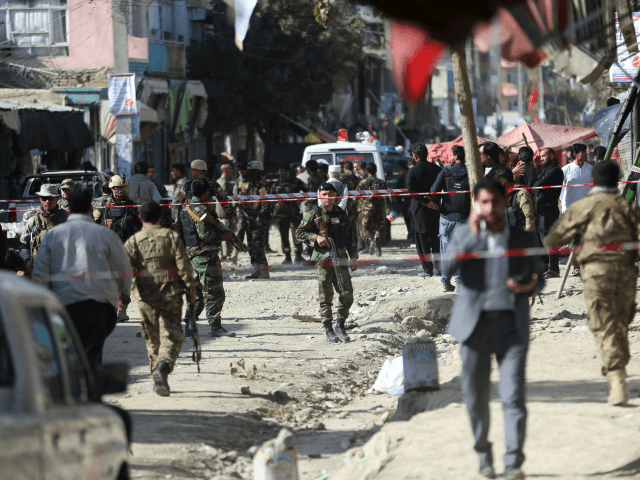The United Nations (U.N.) documented a “sharp increase” in jihadi attacks primarily targeting Shiite Muslims in Afghanistan, including worshippers inside mosques, shrines, and other religious sites as well as imams and religious scholars.
The U.N. found that 273 fatalities and 577 injuries occurred since January 2016, nearly doubling the cumulative number of civilian casualties in such incidents during the previous seven years.
Nearly 90 percent (242 killed, 495 wounded) of the casualties involved suicide attacks on Shiite places of worship primarily carried out by Islamic State (ISIS/ISIL) terrorists, reveals the U.N. Assistance Mission in Afghanistan (UNAMA).
According to the United Nations, since the beginning of January 2016, there have been 51 incidents involving “attacks against places of worship and persons exercising their right to religious worship, observance, and practice and targeted killings, abductions, and intimidation of religious scholars and religious leaders, mainly by Anti-Government Elements.”
The attacks by the anti-Kabul elements, which refers to jihadist groups, resulted in a total of “850 civilian casualties (273 killed and 577 injured), nearly double the number of civilian casualties recorded in such attacks during the entire previous seven-year period from 2009 to 2015,” reports the U.N., noting:
In addition to direct attacks against religious leaders and mosques, in 2016 and 2017 parties to the conflict increasingly targeted individuals perceived as military targets whilst worshipping inside mosques and at other religious sites, resulting in the death of 28 civilians and injury of 15 more.
The unprincipled brutality of such attacks is reflected in the appalling human cost.
Of the total number of casualties, the U.N. documented 87 (24 killed, 63 injured) involving women in addition to 145 child casualties (24 killed, 121 injured).
UNAMA notes that the ISIS wing in Afghanistan is responsible for the vast majority of casualties, which mainly involved Shiite worshippers at mosques, shrines, and other places of worship.
Meanwhile, the U.N. attributes the majority of fatal attacks targeting religious figures, including imams and scholars, to the Taliban, noting that many of those fatalities stemmed from criticism against the terrorist group.
Taliban terrorists are primarily responsible for the 27 targeted killing incidents involving religious figures since 2016, which resulted in 28 deaths and 23 injuries.
The U.N. explains:
The targeting of religious leaders stemmed from to their ability to change public attitude through their messages, or their perceived support of the Government.
…Since 2016, UNAMA documented several incidents of Anti-Government Elements killing religious scholars who had publicly challenged the legality of their quasi-government functions and raised concern about military operations and violence.
Most Shiite Muslims in Sunni-majority Afghanistan belong to the ethnic Hazara community.
The U.N. report covers attacks between the beginning of January 2016 and November 7, 2017.
According to the Pentagon, the Afghanistan-Pakistan region is home to the world’s “highest concentration” of predominantly Sunni jihadist groups, including the Taliban, ISIS, the Haqqani Network, and al-Qaeda, among many others.
Although the Taliban is the most prominent terrorist group in Afghanistan, the Pentagon has deemed its ally the Haqqani Network as the “primary threat” facing U.S. troops and their allies.
Echoing the UNAMA findings, the New York Times (NYT) reported in May that Afghan Taliban jihadists are increasingly targeting Islamic scholars to silence dissent and criticism as the terrorist group continues to expand its reach across the country.
The U.S. Special Inspector General for Afghanistan Reconstruction (SIGAR) found that, despite the dramatic increase in airstrikes against Afghan jihadists under the Trump administration, terrorists, mainly the Taliban, controlled or contested nearly 45 percent of Afghanistan as of late August.
Under President Donald Trump, the U.S. has stepped up military operations against Afghan terrorists.
Specifically, Trump has approved the deployment of as many as 4,000 additional American troops to Afghanistan, bringing the total to about 11,000.
Moreover, NATO recently agreed to send an estimated 3,000 non-combat troops, which will raise the total number of Western forces in the war-ravaged country to above 20,000, reports Reuters, citing current and projected troop numbers and noting that it is “well below a 2011 peak of more than 100,000.”
NATO troops are expected to only focus on training the Afghan security forces while American troops will continue to engage counter-terrorism operations.
Mullah Abdul Saeed, a Taliban commander, recently boasted, “150,000 Americans couldn’t kill us,” claiming that “10-15 people” join the terrorist group “every day” in just one of the 34 provinces in Afghanistan.

COMMENTS
Please let us know if you're having issues with commenting.